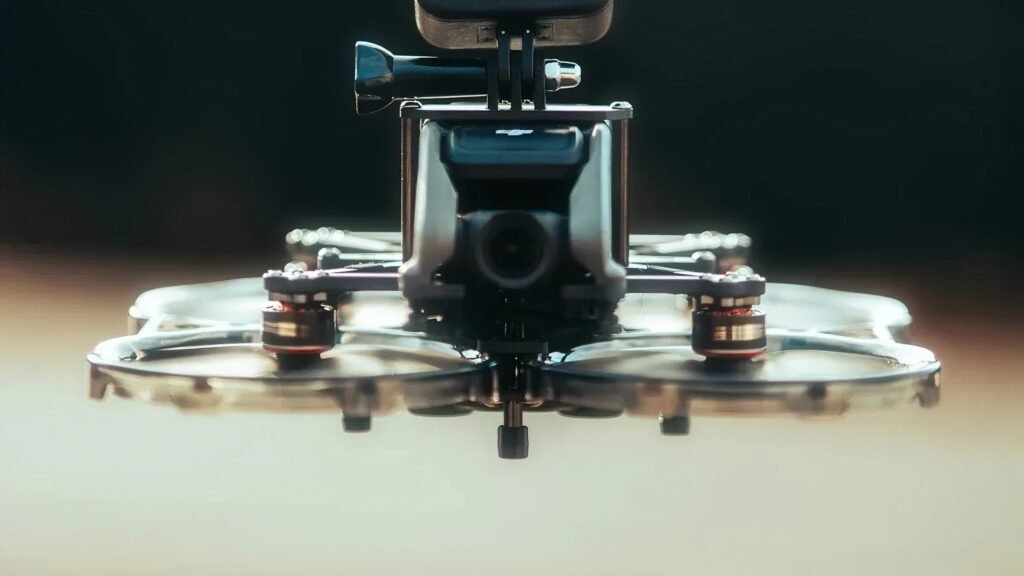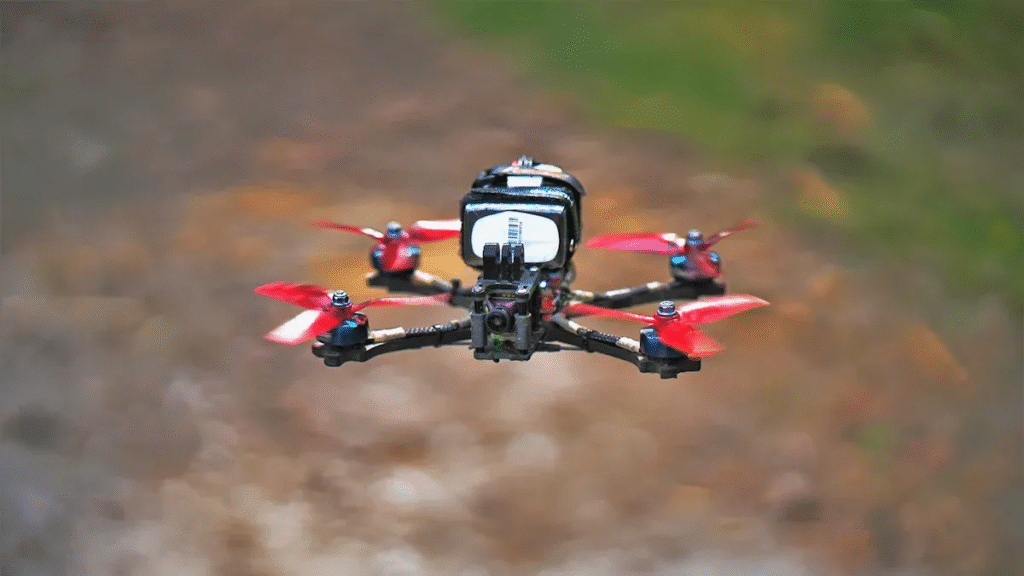Choosing the right FPV motors for your drone is essential for achieving peak performance. Lightweight, efficient FPV motors directly impact flight time and stability. Optimized motor efficiency in FPV motors ensures better power management, enabling longer flights and smoother control. As drones handle larger payloads, durable FPV motors have become vital for reliability in demanding applications.
Frame Size, Propellers, and Choosing the Right Motor

How Frame Size Affects Motor Selection
The frame size of your drone plays a pivotal role in determining the type of FPV motors you need. Larger frames require motors capable of generating higher thrust to support the increased weight and larger propellers. Smaller frames, on the other hand, demand lightweight motors optimized for agility and efficiency.
- Key considerations for motor selection based on frame size:
- The frame size dictates the maximum propeller diameter and pitch that can be used.
- For racing drones, smaller frames (e.g., 5-inch) prioritize speed and maneuverability, requiring motors with higher KV ratings.
- Larger frames (e.g., 6-inch or more) focus on stability and payload capacity, necessitating motors with lower KV ratings and larger stator sizes.
To illustrate, a 5-inch racing drone typically pairs with 2204–2306 brushless motors, offering a KV range of 2100–2800 for optimal performance. In contrast, a 6-inch drone might use 2205–2308 motors with KV ratings between 1600–2500 to balance thrust and efficiency.
| Frame Size (Wheelbase) | Propeller | Motor | KV |
|---|---|---|---|
| 100mm | 2inch | 1102 – 1104 | 6000+ |
| 120mm | 3inch | 1104 – 1106 | 4000+ |
| 150 – 180mm | 4inch | 1306 – 1408 | 3000+ |
| 200-220mm | 5inch | 2204 – 2306 | 2100 – 2800 |
| 235 – 280mm | 6inch | 2205 – 2308 | 1600 – 2500 |
When choosing the right size motor, consider the thrust-to-weight ratio. A higher ratio ensures better agility and motor performance, especially for racing drones. However, exceeding the recommended motor size for your frame can reduce motor efficiency and flight time.
Matching Propeller Size and Pitch to FPV Motors
Propeller size and pitch directly impact the performance of your FPV drone motors. Larger propellers generate more thrust but place a heavier load on the motors, reducing efficiency. Smaller propellers are lighter and faster, making them ideal for racing drones.
| Propeller Configuration | Thrust Impact | Efficiency Consideration |
|---|---|---|
| Higher Pitch | More Thrust | Increased Motor Load |
| Different Diameter | Varies | Affects Efficiency |
| Triple Blade Props | Speed Focus | Less Concern for Efficiency |
When selecting propellers, match their size and pitch to the motor’s KV rating and stator size. For example:
- Higher pitch propellers: These provide more thrust but increase the load on the brushless motor, reducing flight time.
- Triple-blade props: These enhance speed and agility but may sacrifice motor efficiency.
To achieve optimal performance, balance thrust and efficiency. For racing drones, prioritize speed and agility by pairing high-KV motors with smaller, high-pitch propellers. For larger drones, focus on stability and payload capacity by using lower-KV motors with larger propellers.
Tip: Always test your propeller and motor combinations to find the best setup for your drone’s total weight and intended use. This ensures the thrust-to-weight ratio aligns with your performance goals.
Understanding FPV Drone Motor Specifications
KV Rating and Its Role in Performance
The KV rating is one of the most critical specifications to understand when evaluating FPV drone motors. It represents the number of revolutions per minute (RPM) a motor achieves per volt applied. Higher KV ratings result in faster RPMs, making them ideal for racing drones that prioritize speed and agility. Lower KV ratings, on the other hand, offer better torque and efficiency, which are essential for drones carrying heavier payloads or focusing on stability.
For example, if you use a 4s LiPo battery with a fully charged voltage of 16.8 volts (4.2 volts per cell x 4 cells) and pair it with a motor rated at 880 KV, the maximum RPM would be 14,784 (16.8 volts x 880 KV). This calculation highlights how KV ratings directly influence motor performance. High KV motors excel in delivering high power outputs and rapid acceleration, but they may sacrifice flight time due to increased current draw.
When choosing the right motor size for your drone, consider the intended use. Racing drones benefit from high KV brushless motors paired with smaller, high-pitch propellers to maximize speed. For larger drones or cinematic builds, lower KV ratings paired with larger propellers ensure smoother control and longer flight times.
Tip: Always test KV ratings in combination with your propeller and battery setup to achieve the optimal motor for your build. This ensures the thrust-to-weight ratio aligns with your drone’s performance goals.
Stator Size, Thrust, and Weight Considerations
The stator size of a brushless motor plays a significant role in determining its thrust and efficiency. Stators are measured by their diameter and height (e.g., 2204, where 22 mm is the diameter and 4 mm is the height). Larger stators generate more thrust, making them suitable for drones with higher total weight or those requiring stability during flight. Smaller stators, however, are lighter and more efficient, which is ideal for racing drones focused on agility.
When analyzing motor thrust data, consider the following technical benchmarks:
- Efficiency: Evaluate motor efficiency across the throttle range, especially at the levels you primarily fly.
- Torque: Higher torque improves responsiveness and precision, allowing for quicker RPM changes.
- Response Time: Faster response times enhance motor performance, particularly for racing drones.
- Temperature: Motors that overheat lose efficiency and may degrade over time.
- Vibration: Poorly balanced motors can cause vibrations, negatively impacting flight stability and tuning.
Additionally, metrics like grams per amp and current draw provide valuable insights into motor efficiency. Grams per amp measures thrust relative to current draw, helping you identify motors that deliver high thrust without draining your battery excessively. Propeller compatibility also plays a key role, as different propeller configurations can significantly affect motor performance.
To choose the right size motor, balance thrust-to-weight ratio with your drone’s total weight and intended use. Racing drones benefit from smaller stators and high-KV ratings for speed, while larger drones require bigger stators and lower KV ratings for stability and payload capacity.
Note: Always prioritize motor efficiency and durability when selecting FPV drone motors. This ensures reliable performance and extends the lifespan of your electric FPV drone motor.
Balancing Durability, Budget, and Performance
Key Features for Long-Lasting FPV Drone Motors
When selecting FPV drone motors, durability is a critical factor that directly impacts performance and longevity. High-quality materials and precise construction ensure your motors withstand the demands of intense flights. For example, motors made with titanium shafts and 60 82 series aluminum offer both strength and lightweight performance, reducing wear and tear over time. Additionally, components like N45 magnets and well-balanced parts contribute to smooth operation and efficient power delivery, which are essential for long-lasting motor performance.
Weight also plays a significant role in motor durability. Heavier motors resist changes in acceleration, which can lead to poor responsiveness and inaccurate flight characteristics. Opting for lighter motors improves agility and reduces strain on your drone’s frame. Furthermore, tuning your motors for optimal throttle feel and resolution enhances control, making it easier to maintain a steady hover and execute precise adjustments.
To maximize the lifespan of your FPV drone motors, focus on choosing components that complement your build. Pairing the right propellers and KV rating with your motor ensures better efficiency and performance during flights. This balance not only improves thrust-to-weight ratio but also minimizes unnecessary stress on the motors.
Tips for Choosing the Right Motor on a Budget
Building a custom drone doesn’t have to break the bank. By prioritizing key features and understanding your drone’s requirements, you can find high-performance brushless motors that fit your budget. Start by identifying your drone’s intended use. Racing drones, for instance, require high-KV brushless motors for speed and agility, while cinematic or payload-focused drones benefit from lower KV ratings and larger stators for stability.
Look for motors that offer a balance between cost and quality. Many budget-friendly options feature durable materials like aluminum and well-balanced components, ensuring reliable performance without excessive costs. Avoid motors with overly high KV ratings if your drone isn’t designed for racing, as these can drain your battery quickly and reduce flight time.
When choosing the right motor size, consider the thrust-to-weight ratio. A higher ratio improves agility and motor performance, especially for competition drones. However, exceeding the recommended motor size can lead to inefficiencies. Researching reviews and comparing specifications helps you identify motors that deliver the best value for your money.
Tip: Investing in slightly higher-quality motors upfront can save you money in the long run by reducing the need for frequent replacements.
Matching the right FPV drone motor to your drone’s frame size, power source, and intended use ensures optimal performance. Testing and fine-tuning motors is essential for achieving the best results. Factors like motor weight, size, torque, and efficiency play a critical role in this process.
| Factor | Description |
|---|---|
| Motor Weight | Critical for balancing performance and operational efficiency in drone applications. |
| Motor Size | Must be optimized to ensure compatibility with drone design and performance requirements. |
| Torque | High torque is necessary for carrying heavy loads efficiently. |
| Efficiency | Optimized designs lead to higher efficiency compared to benchmark models. |
| Iterative Design Process | Multiple iterations of design elements resulted in successful motor optimization. |
| Benchmark Comparison | The modified optimized BLDC motor outperformed the competitive design in efficiency and power. |
Prioritize motor compatibility, efficiency, and quality to enhance your drone’s capabilities. Whether you’re building a racing drone or a cinematic setup, fine-tuning your kv rating and propeller combinations will help you achieve peak performance.



